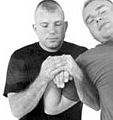Hapkido facts for kids
Hapkido (Korean: 합기도; Hanja: 合氣道, pronounced "HAP-kee-doh") is a cool Korean martial art. The name means "the way of coordinating energy."
It's a mix of different fighting styles, like the powerful kicks and punches you might see in taekwondo. It also includes joint locks and throws, similar to what you'd find in Aikido. Hapkido is mostly about self-defense. It teaches you how to protect yourself using various techniques.
Contents
The Story of Hapkido
The history of Hapkido can be a bit tricky to follow. However, many experts believe it was mainly developed by two important Koreans: Choi Yong Sul (who lived from 1904 to 1986) and Ji Han Jae (born in 1936).
Choi Yong Sul's Early Life
When Choi Yong Sul was a child, he traveled to Japan. There, it seems he worked for a famous martial arts master named Sokaku Takeda. Takeda taught a style called Daito-ryu Aiki-jutsu.
Choi Yong Sul was very good at learning this style. Master Takeda often sent him to challenge other martial artists. This helped Choi learn a lot about different fighting methods.
Hapkido's Development in Korea
After returning to Korea, Choi Yong Sul started teaching martial arts. One of his students was Ji Han Jae. Ji Han Jae added many traditional Korean techniques to what Choi taught.
These new techniques included powerful kicks and punches, which came from older Korean martial arts like Taekkyon and hwarangdo. In 1959, Ji Han Jae officially named this new combined style "Hapkido."
Many Contributions to Hapkido
Besides Choi and Ji, many other Korean martial arts schools helped shape Hapkido. They added different techniques and ideas. This is why Hapkido today has such a wide range of moves and strategies.
Images for kids
-
Hapkido students practicing grappling techniques.
-
Hapkido shares many throwing techniques with judo.
-
Nunchaku (Ssahng Jol Gohn; 쌍절곤), one of the weapons used in Hapkido.
See also
 In Spanish: Hapkido para niños
In Spanish: Hapkido para niños












